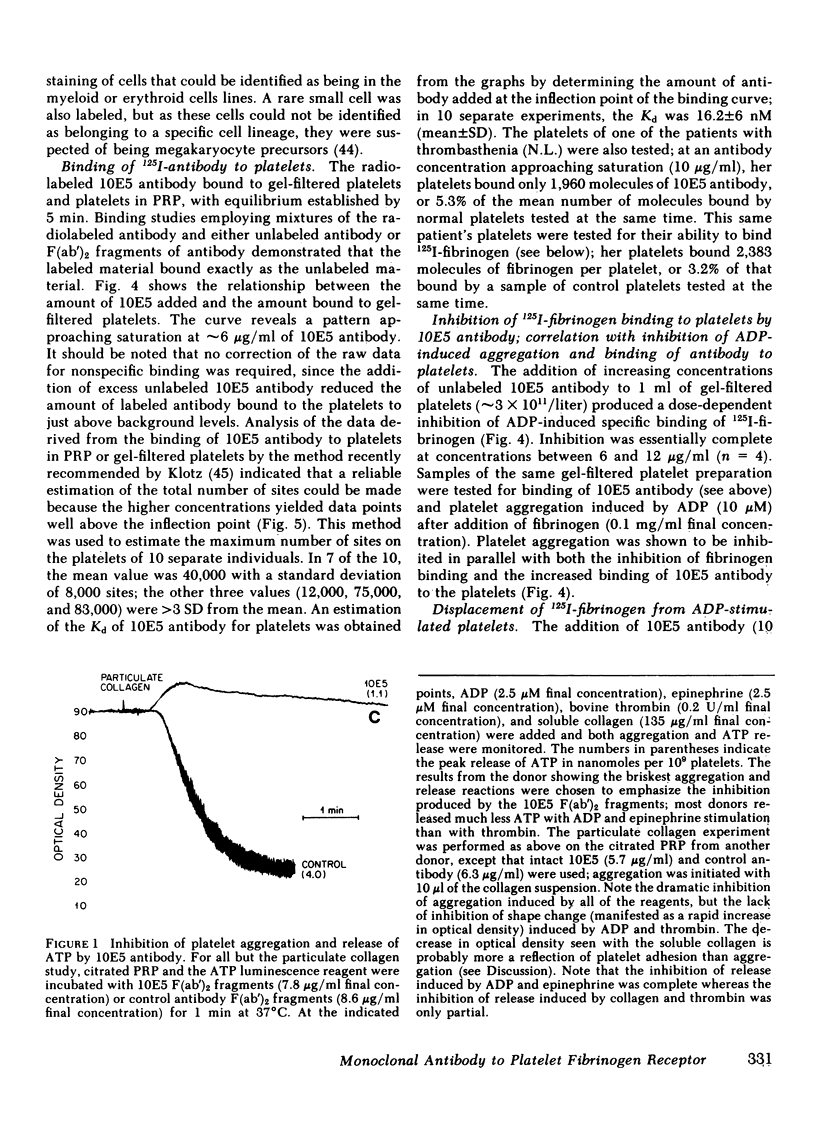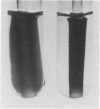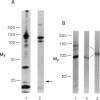Abstract
To define better the role of the fibrinogen receptor in platelet physiology and to characterize it biochemically, a murine monoclonal antibody that completely blocks the binding of fibrinogen to the platelet surface was produced by the hybridoma technique with the aid of a functional screening assay. Purified F(ab')2 fragments and/or intact antibody completely blocked aggregation induced by ADP, thrombin, or epinephrine and the binding of radiolabeled fibrinogen to platelets induced by ADP. The antibody did not block agglutination of formaldehyde-fixed platelets by ristocetin or shape change induced by either ADP or thrombin. ADP- and epinephrine-induced release of ATP was completely inhibited by the antibody, but inhibition of release induced by collagen and thrombin was dose dependent and partial. The antibody also dramatically inhibited platelet retention in glass-bead columns, platelet adhesion to glass, and clot retraction. Thus, the antibody induced a thrombasthenic-like state. Immunofluorescent studies confirmed the specificity of the antibody for normal platelets and megakaryocytes and suggested that there is a marked decrease in detectable antigen in thrombasthenic platelets. Radiolabeled antibody bound to an average of approximately 40,000 sites on normal platelets but it bound to less than 2,000 sites on the platelets of a patient with thrombasthenia. The antibody immunoprecipitated both glycoproteins IIb and IIIa, and both glycoproteins bound to an affinity column of the antibody. These studies indicate that there is probably a single anatomic site that is crucial to the binding of all fibrinogen molecules and that this site is most likely on the glycoprotein IIb/IIIa complex. It also suggests that the thrombasthenic phenotype can be completely accounted for on the basis of the inhibition of fibrinogen binding to platelets.
Full text
PDF













Images in this article
Selected References
These references are in PubMed. This may not be the complete list of references from this article.
- BRINKHOUS K. M., READ M. S., MASON R. G. PLASMA THROMBOCYTE-AGGLUTINATING ACTIVITY AND FIBRINOGEN. SYNERGISM WITH ADENOSINE DIPHOSPHATE. Lab Invest. 1965 Apr;14:335–342. [PubMed] [Google Scholar]
- Bennett J. S., Hoxie J. A., Leitman S. F., Vilaire G., Cines D. B. Inhibition of fibrinogen binding to stimulated human platelets by a monoclonal antibody. Proc Natl Acad Sci U S A. 1983 May;80(9):2417–2421. doi: 10.1073/pnas.80.9.2417. [DOI] [PMC free article] [PubMed] [Google Scholar]
- Bennett J. S., Vilaire G., Burch J. W. A role for prostaglandins and thromboxanes in the exposure of platelet fibrinogen receptors. J Clin Invest. 1981 Oct;68(4):981–987. doi: 10.1172/JCI110352. [DOI] [PMC free article] [PubMed] [Google Scholar]
- Bennett J. S., Vilaire G. Exposure of platelet fibrinogen receptors by ADP and epinephrine. J Clin Invest. 1979 Nov;64(5):1393–1401. doi: 10.1172/JCI109597. [DOI] [PMC free article] [PubMed] [Google Scholar]
- Bonner W. M., Laskey R. A. A film detection method for tritium-labelled proteins and nucleic acids in polyacrylamide gels. Eur J Biochem. 1974 Jul 1;46(1):83–88. doi: 10.1111/j.1432-1033.1974.tb03599.x. [DOI] [PubMed] [Google Scholar]
- CROSS M. J. EFFECT OF FIBRINOGEN ON THE AGGREGATION OF PLATELETS BY ADENOSINE DIPHOSPHATE. Thromb Diath Haemorrh. 1964 Dec 31;12:524–527. [PubMed] [Google Scholar]
- Caen J. P., Cronberg S., Levy-Toledano S., Kubisz P., Pinkhas J. P. New data on Glanzmann's thrombasthenia. Proc Soc Exp Biol Med. 1971 Apr;136(4):1082–1086. doi: 10.3181/00379727-136-35432. [DOI] [PubMed] [Google Scholar]
- Caen J. P., Michel H. Platelet shape change and aggregation. Nature. 1972 Nov 17;240(5377):148–149. doi: 10.1038/240148a0. [DOI] [PubMed] [Google Scholar]
- Charo I. F., Feinman R. D., Detwiler T. C. Interrelations of platelet aggregation and secretion. J Clin Invest. 1977 Oct;60(4):866–873. doi: 10.1172/JCI108841. [DOI] [PMC free article] [PubMed] [Google Scholar]
- Chediak J., Telfer M. C., Vander Laan B., Maxey B., Cohen I. Cycles of agglutination-disagglutination induced by ristocetin in thrombasthenic platelets. Br J Haematol. 1979 Sep;43(1):113–126. doi: 10.1111/j.1365-2141.1979.tb03726.x. [DOI] [PubMed] [Google Scholar]
- Cohen I., Glaser T., Seligsohn U. Effects of ADP and ATP on bovine fibrinogen- and ristocetin-induced platelet aggregation in Glanzmann's thrombasthenia. Br J Haematol. 1975 Nov;31(3):343–347. doi: 10.1111/j.1365-2141.1975.tb00865.x. [DOI] [PubMed] [Google Scholar]
- Coller B. S. Asialofibrinogen supports platelet aggregation and adhesion to glass. Blood. 1979 Feb;53(2):325–332. [PubMed] [Google Scholar]
- Coller B. S., Franza B. R., Jr, Gralnick H. R. The pH dependence of quantitative ristocetin-induced platelet aggregation: theoretical and practical implications-a new device for maintenance of platelet-rich plasma pH. Blood. 1976 May;47(5):841–854. [PubMed] [Google Scholar]
- Coller B. S., Gralnick H. R. The effect of stir bar size and shape on quantitative platelet aggregation. Thromb Res. 1976 Feb;8(2):121–129. doi: 10.1016/0049-3848(76)90255-3. [DOI] [PubMed] [Google Scholar]
- Coller B. S., Hirschman R. J., Gralnick H. R. Studies on the Factor VIII/von Willebrand factor antigen on human platelets. Thromb Res. 1975 Jun;6(6):469–480. doi: 10.1016/0049-3848(75)90059-6. [DOI] [PubMed] [Google Scholar]
- Coller B. S., Hultin M. B., Hoyer L. W., Miller F., Dobbs J. V., Dosik M. H., Berger E. R. Normal pregnancy in a patient with a prior postpartum factor VIII inhibitor: with observations on pathogenesis and prognosis. Blood. 1981 Sep;58(3):619–624. [PubMed] [Google Scholar]
- Coller B. S. Inhibition of von Willebrand factor-dependent platelet function by increased platelet cyclic AMP and its prevention by cytoskeleton-disrupting agents. Blood. 1981 May;57(5):846–855. [PubMed] [Google Scholar]
- Coller B. S. Interaction of normal, thrombasthenic, and Bernard-Soulier platelets with immobilized fibrinogen: defective platelet-fibrinogen interaction in thrombasthenia. Blood. 1980 Feb;55(2):169–178. [PubMed] [Google Scholar]
- Coller B. S., Zarrabi M. H. Platelet membrane studies in the May-Hegglin anomaly. Blood. 1981 Aug;58(2):279–284. [PubMed] [Google Scholar]
- Coller H. A., Coller B. S. Statistical analysis of repetitive subcloning by the limiting dilution technique with a view toward ensuring hybridoma monoclonality. Hybridoma. 1983;2(1):91–96. doi: 10.1089/hyb.1983.2.91. [DOI] [PubMed] [Google Scholar]
- Degos L., Dautigny A., Brouet J. C., Colombani M., Ardaillou N., Caen J. P., Colombani J. A molecular defect in thrombasthenic platelets. J Clin Invest. 1975 Jul;56(1):236–240. doi: 10.1172/JCI108074. [DOI] [PMC free article] [PubMed] [Google Scholar]
- Di Minno G., Thiagarajan P., Perussia B., Martinez J., Shapiro S., Trinchieri G., Murphy S. Exposure of platelet fibrinogen-binding sites by collagen, arachidonic acid, and ADP: inhibition by a monoclonal antibody to the glycoprotein IIb-IIIa complex. Blood. 1983 Jan;61(1):140–148. [PubMed] [Google Scholar]
- Ey P. L., Prowse S. J., Jenkin C. R. Isolation of pure IgG1, IgG2a and IgG2b immunoglobulins from mouse serum using protein A-sepharose. Immunochemistry. 1978 Jul;15(7):429–436. doi: 10.1016/0161-5890(78)90070-6. [DOI] [PubMed] [Google Scholar]
- Gugler E., Lüscher E. F. Platelet function in congenital afibrinogenemia. Thromb Diath Haemorrh. 1965 Nov 15;14(3-4):361–373. [PubMed] [Google Scholar]
- Hagen I., Nurden A., Bjerrum O. J., Solum N. O., Caen J. Immunochemical evidence for protein abnormalities in platelets from patients with Glanzmann's thrombasthenia and Bernard-Soulier syndrome. J Clin Invest. 1980 Mar;65(3):722–731. doi: 10.1172/JCI109719. [DOI] [PMC free article] [PubMed] [Google Scholar]
- Hangen I., Bjerrum O. J., Gogstad G., Korsmo R., Solum N. O. Involvement of divalent cations in the complex between the platelet glycoproteins IIb and IIIa. Biochim Biophys Acta. 1982 Feb 4;701(1):1–6. doi: 10.1016/0167-4838(82)90303-x. [DOI] [PubMed] [Google Scholar]
- Hawiger J., Parkinson S., Timmons S. Prostacyclin inhibits mobilisation of fibrinogen-binding sites on human ADP- and thrombin-treated platelets. Nature. 1980 Jan 10;283(5743):195–197. doi: 10.1038/283195a0. [DOI] [PubMed] [Google Scholar]
- Hawiger J., Timmons S., Kloczewiak M., Strong D. D., Doolittle R. F. gamma and alpha chains of human fibrinogen possess sites reactive with human platelet receptors. Proc Natl Acad Sci U S A. 1982 Mar;79(6):2068–2071. doi: 10.1073/pnas.79.6.2068. [DOI] [PMC free article] [PubMed] [Google Scholar]
- Heptinstall S., Taylor P. M. The effects of citrate and extracellular calcium ions on the platelet release reaction induced by adenosine diphosphate and collagen. Thromb Haemost. 1979 Aug 31;42(2):778–793. [PubMed] [Google Scholar]
- Howard L., Shulman S., Sadanandan S., Karpatkin S. Crossed immunoelectrophoresis of human platelet membranes. The major antigen consists of a complex of glycoproteins, GPIIb and GPIIIa, held together by Ca2+ and missing in Glanzmann's thrombasthenia. J Biol Chem. 1982 Jul 25;257(14):8331–8336. [PubMed] [Google Scholar]
- Howard M. A., Firkin B. G. Ristocetin--a new tool in the investigation of platelet aggregation. Thromb Diath Haemorrh. 1971 Oct 31;26(2):362–369. [PubMed] [Google Scholar]
- Inceman S., Caen J., Bernard J. Aggregation, adhesion, and viscous metamorphosis of platelets in congenital fibrinogen deficiencies. J Lab Clin Med. 1966 Jul;68(1):21–32. [PubMed] [Google Scholar]
- Jenkins C. S., Ali-Briggs E. F., Clemetson K. J. Antibodies against platelet membrane glycoproteins. II. Influence on ADP- and collagen-induced platelet aggregation, crossed immunoelectrophoresis studies and relevance to Glanzmann's thrombasthenia. Br J Haematol. 1981 Nov;49(3):439–447. doi: 10.1111/j.1365-2141.1981.tb07247.x. [DOI] [PubMed] [Google Scholar]
- Kaplan K. L., Nachman R. L. The effect of platelet membrane antibodies on aggregation and release. Br J Haematol. 1974 Dec;28(4):551–560. doi: 10.1111/j.1365-2141.1974.tb06674.x. [DOI] [PubMed] [Google Scholar]
- Kearney J. F., Radbruch A., Liesegang B., Rajewsky K. A new mouse myeloma cell line that has lost immunoglobulin expression but permits the construction of antibody-secreting hybrid cell lines. J Immunol. 1979 Oct;123(4):1548–1550. [PubMed] [Google Scholar]
- Kessler S. W. Rapid isolation of antigens from cells with a staphylococcal protein A-antibody adsorbent: parameters of the interaction of antibody-antigen complexes with protein A. J Immunol. 1975 Dec;115(6):1617–1624. [PubMed] [Google Scholar]
- Klotz I. M. Numbers of receptor sites from Scatchard graphs: facts and fantasies. Science. 1982 Sep 24;217(4566):1247–1249. doi: 10.1126/science.6287580. [DOI] [PubMed] [Google Scholar]
- Kornecki E., Niewiarowski S., Morinelli T. A., Kloczewiak M. Effects of chymotrypsin and adenosine diphosphate on the exposure of fibrinogen receptors on normal human and Glanzmann's thrombasthenic platelets. J Biol Chem. 1981 Jun 10;256(11):5696–5701. [PubMed] [Google Scholar]
- Kunicki T. J., Pidard D., Rosa J. P., Nurden A. T. The formation of Ca++-dependent complexes of platelet membrane glycoproteins IIb and IIIa in solution as determined by crossed immunoelectrophoresis. Blood. 1981 Aug;58(2):268–278. [PubMed] [Google Scholar]
- Köhler G., Milstein C. Continuous cultures of fused cells secreting antibody of predefined specificity. Nature. 1975 Aug 7;256(5517):495–497. doi: 10.1038/256495a0. [DOI] [PubMed] [Google Scholar]
- Laemmli U. K. Cleavage of structural proteins during the assembly of the head of bacteriophage T4. Nature. 1970 Aug 15;227(5259):680–685. doi: 10.1038/227680a0. [DOI] [PubMed] [Google Scholar]
- Lee H., Nurden A. T., Thomaidis A., Caen J. P. Relationship between fibrinogen binding and the platelet glycoprotein deficiencies in Glanzmann's thrombasthenia type I and type II. Br J Haematol. 1981 May;48(1):47–57. doi: 10.1111/j.1365-2141.1981.00047.x. [DOI] [PubMed] [Google Scholar]
- Leung L. L., Kinoshita T., Nachman R. L. Isolation, purification, and partial characterization of platelet membrane glycoproteins IIb and IIIa. J Biol Chem. 1981 Feb 25;256(4):1994–1997. [PubMed] [Google Scholar]
- Levy-Toledano S., Maclouf J., Rendu F., Rigaud M., Caen J. P. Ionophore A 23187 and thrombasthenic platelets : a model for dissociating serotonin release and thromboxane formation from true aggregation. Thromb Res. 1979;16(3-4):453–462. doi: 10.1016/0049-3848(79)90092-6. [DOI] [PubMed] [Google Scholar]
- Levy-Toledano S., Tobelem G., Legrand C., Bredoux R., Degos L., Nurden A., Caen J. P. Acquired IgG antibody occurring in a thrombasthenic patient: its effect on human platelet function. Blood. 1978 Jun;51(6):1065–1071. [PubMed] [Google Scholar]
- Levy R., Dilley J., Lampson L. A. Human normal and leukemia cell surface antigens. Mouse monoclonal antibodies as probes. Curr Top Microbiol Immunol. 1978;81:164–169. doi: 10.1007/978-3-642-67448-8_26. [DOI] [PubMed] [Google Scholar]
- MOSESSON M. W. The preparation of human fibrinogen free of plasminogen. Biochim Biophys Acta. 1962 Feb 26;57:204–213. doi: 10.1016/0006-3002(62)91112-5. [DOI] [PubMed] [Google Scholar]
- Malmsten C., Kindahl H., Samuelsson B., Levy-Toledano S., Tobelem G., Caen J. P. Thromboxane synthesis and the platelet release reaction in Bernard-Soulier syndrome, thrombasthenia Glanzmann and Hermansky-Pudlak syndrome. Br J Haematol. 1977 Apr;35(4):511–520. doi: 10.1111/j.1365-2141.1977.tb00617.x. [DOI] [PubMed] [Google Scholar]
- Marguerie G. A., Plow E. F., Edgington T. S. Human platelets possess an inducible and saturable receptor specific for fibrinogen. J Biol Chem. 1979 Jun 25;254(12):5357–5363. [PubMed] [Google Scholar]
- McEver R. P., Baenziger N. L., Majerus P. W. Isolation and quantitation of the platelet membrane glycoprotein deficient in thrombasthenia using a monoclonal hybridoma antibody. J Clin Invest. 1980 Dec;66(6):1311–1318. doi: 10.1172/JCI109983. [DOI] [PMC free article] [PubMed] [Google Scholar]
- McEver R. P., Bennett E. M., Martin M. N. Identification of two structurally and functionally distinct sites on human platelet membrane glycoprotein IIb-IIIa using monoclonal antibodies. J Biol Chem. 1983 Apr 25;258(8):5269–5275. [PubMed] [Google Scholar]
- McGregor J. L., Clemetson K. J., James E., Capitanio A., Greenland T., Lüscher E. F., Dechavanne M. Glycoproteins of platelet membranes from Glanzmann's thrombasthenia. A comparison with normal using carbohydrate-specific or protein-specific labelling techniques and high-resolution two-dimensional gel electrophoresis. Eur J Biochem. 1981 May 15;116(2):379–388. doi: 10.1111/j.1432-1033.1981.tb05346.x. [DOI] [PubMed] [Google Scholar]
- Miller J. L., Katz A. J., Feinstein M. B. Plasmin inhibition of thrombin-induced platelet aggregation. Thromb Diath Haemorrh. 1975 Apr 30;33(2):286–309. [PubMed] [Google Scholar]
- Mustard J. F., Kinlough-Rathbone R. L., Packham M. A., Perry D. W., Harfenist E. J., Pai K. R. Comparison of fibrinogen association with normal and thrombasthenic platelets on exposure to ADP or chymotrypsin. Blood. 1979 Nov;54(5):987–993. [PubMed] [Google Scholar]
- Nachman R. L., Leung L. L. Complex formation of platelet membrane glycoproteins IIb and IIIa with fibrinogen. J Clin Invest. 1982 Feb;69(2):263–269. doi: 10.1172/JCI110448. [DOI] [PMC free article] [PubMed] [Google Scholar]
- Nurden A. T., Caen J. P. An abnormal platelet glycoprotein pattern in three cases of Glanzmann's thrombasthenia. Br J Haematol. 1974 Oct;28(2):253–260. doi: 10.1111/j.1365-2141.1974.tb06660.x. [DOI] [PubMed] [Google Scholar]
- O'Brien J. R. Effects of adenosine diphosphate and adrenaline on mean platelet shape. Nature. 1965 Jul 17;207(994):306–307. doi: 10.1038/207306b0. [DOI] [PubMed] [Google Scholar]
- Parham P., Barnstable C. J., Bodmer W. F. Use of a monoclonal antibody (W6/32) in structural studies of HLA-A,B,C, antigens. J Immunol. 1979 Jul;123(1):342–349. [PubMed] [Google Scholar]
- Peerschke E. I., Zucker M. B., Grant R. A., Egan J. J., Johnson M. M. Correlation between fibrinogen binding to human platelets and platelet aggregability. Blood. 1980 May;55(5):841–847. [PubMed] [Google Scholar]
- Phillips D. R., Agin P. P. Platelet plasma membrane glycoproteins. Evidence for the presence of nonequivalent disulfide bonds using nonreduced-reduced two-dimensional gel electrophoresis. J Biol Chem. 1977 Mar 25;252(6):2121–2126. [PubMed] [Google Scholar]
- Phillips D. R., Jenkins C. S., Lüscher E. F., Larrieu M. Molecular differences of exposed surface proteins on thrombasthenic platelet plasma membranes. Nature. 1975 Oct 16;257(5527):599–600. doi: 10.1038/257599a0. [DOI] [PubMed] [Google Scholar]
- Solum N. O., Stormorken H. Influence of fibrinogen on the aggregation of washed human blood platelets induced by adenosine diphosphate, thrombin, collagen, and adrenaline. Scand J Clin Lab Invest. 1965;17(Suppl):170+–170+. [PubMed] [Google Scholar]
- Vainchenker W., Deschamps J. F., Bastin J. M., Guichard J., Titeux M., Breton-Gorius J., McMichael A. J. Two monoclonal antiplatelet antibodies as markers of human megakaryocyte maturation: immunofluorescent staining and platelet peroxidase detection in megakaryocyte colonies and in in vivo cells from normal and leukemic patients. Blood. 1982 Mar;59(3):514–521. [PubMed] [Google Scholar]
- Weiss H. J., Kochwa S. Studies of platelet function and proteins in 3 patients with Glanzmann's thrombasthenia. J Lab Clin Med. 1968 Jan;71(1):153–165. [PubMed] [Google Scholar]
- Weiss H. J., Rogers J., Brand H. Defective ristocetin-induced platelet aggregation in von Willebrand's disease and its correction by factor VIII. J Clin Invest. 1973 Nov;52(11):2697–2707. doi: 10.1172/JCI107464. [DOI] [PMC free article] [PubMed] [Google Scholar]
- Weiss H. J., Rogers J. Fibrinogen and platelets in the primary arrest of bleeding. Studies in two patients with congenital afibrinogenemia. N Engl J Med. 1971 Aug 12;285(7):369–374. doi: 10.1056/NEJM197108122850703. [DOI] [PubMed] [Google Scholar]
- Weiss H. J., Tschopp T. B., Baumgartner H. R., Sussman I. I., Johnson M. M., Egan J. J. Decreased adhesion of giant (Bernard-Soulier) platelets to subendothelium. Further implications on the role of the von Willebrand factor in hemostasis. Am J Med. 1974 Dec;57(6):920–925. doi: 10.1016/0002-9343(74)90170-3. [DOI] [PubMed] [Google Scholar]
- Widmer K., Moake J. L., Kent C. J., Yeo Y. Y., Reynolds J. P. Clot retraction: evaluation in dilute suspensions of platelet-rich plasma and gel-separated platelets. J Lab Clin Med. 1976 Jan;87(1):49–57. [PubMed] [Google Scholar]
- Zucker M. B., Pert J. H., Hilgartner M. W. Platelet function in a patient with thrombasthenia. Blood. 1966 Oct;28(4):524–534. [PubMed] [Google Scholar]
- Zucker M. B., Vroman L. Platelet adhesion induced by fibrinogen adsorbed onto glass. Proc Soc Exp Biol Med. 1969 Jun;131(2):318–320. doi: 10.3181/00379727-131-33866. [DOI] [PubMed] [Google Scholar]





